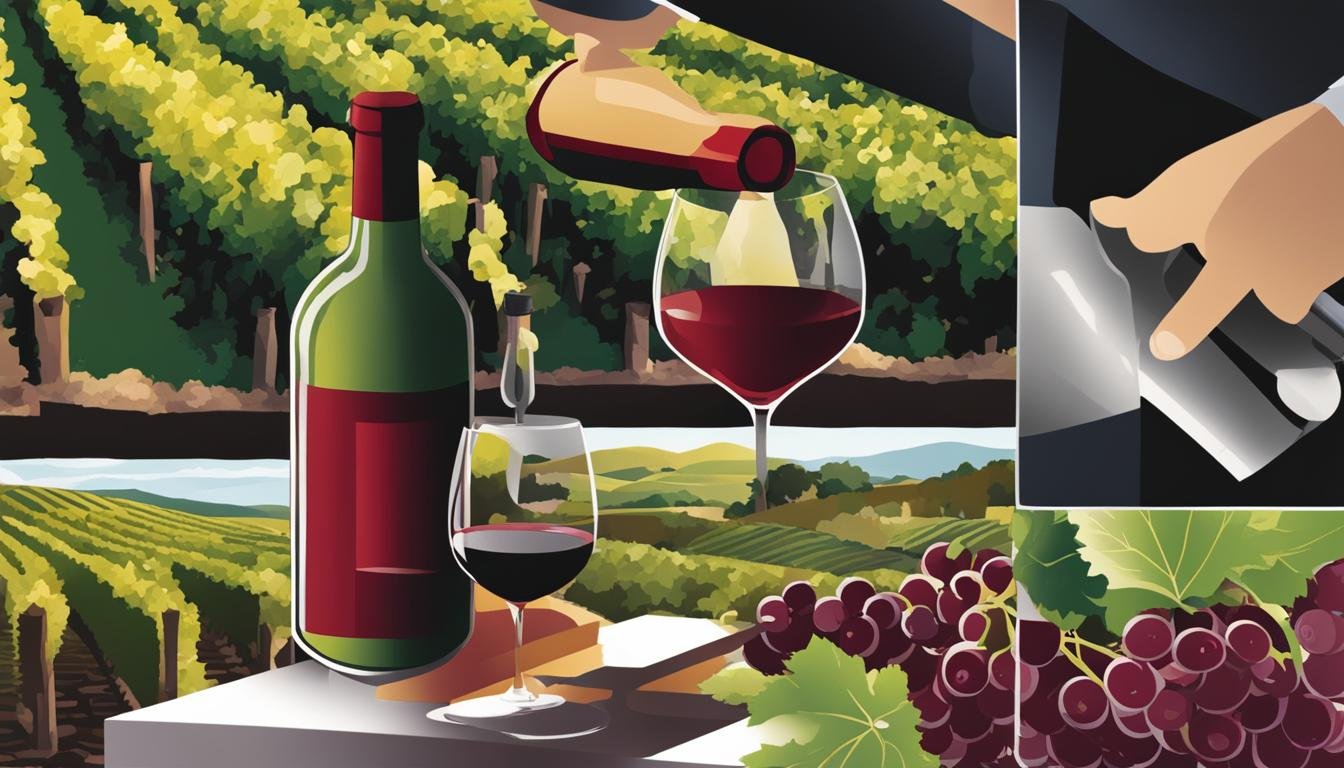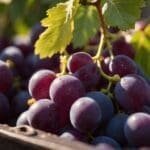This post may contain affiliate links. Please read my disclosure policy.
If you’re planning to throw a corker of a party and want to impress your guests with your wine knowledge, you’ve come to the right place. Before you crack open those bottles, let’s get you acquainted with nine essential wine terms that will make you the life of the party.
From deciphering wine terminology to understanding the nuances of wine tasting, this wine glossary will give you the confidence to navigate the grapevine like a true connoisseur. So, grab a glass, swirl it around, and let’s dive into the world of wine!
Key Takeaways:
- Expand your wine vocabulary by learning essential wine terms before your next party.
- Understand the importance of ABV (Alcohol By Volume) in determining the strength of a wine.
- Discover how acidity affects the taste profile and balance of a wine.
- Unravel the mysteries of tannins and their influence on the structure of red wines.
- Explore different grape varieties and their unique characteristics.
ABV: Alcohol By Volume in Wine
When it comes to wine, one of the key terms you need to know is ABV, which stands for Alcohol By Volume. ABV refers to the alcohol content of a wine and can give you an idea of its strength and potential effects. So, the next time you’re browsing the shelves for a bottle of wine, pay attention to the ABV.
In general, still wines have an ABV range of 11% to 15%. This means that the alcohol content of most wines falls within this range. However, it’s important to note that fortified wines, such as Port or Sherry, can have a higher ABV range of 15% to 22%. These wines have had additional alcohol added, which raises their overall alcohol content.
| Wine Type | ABV Range |
|---|---|
| Still Wines | 11% – 15% |
| Fortified Wines | 15% – 22% |
Remember, the ABV of a wine can affect your experience. If you’re looking for a lighter and more refreshing option, opt for a wine with a lower ABV. On the other hand, if you’re seeking a bolder and more robust experience, a wine with a higher ABV may be just what you’re looking for.
So, whether you’re sipping on a crisp white or enjoying a full-bodied red, understanding the ABV of a wine can help you make informed choices and ensure you’re selecting a bottle that aligns with your preferences and plans. Cheers to exploring the world of wine and raising a glass to ABV!
Acidity and Its Importance in Wine
When it comes to wine, acidity is like the zesty squeeze of lemon that wakes up your taste buds. It adds that refreshing and mouth-watering quality to a glass of vino that keeps you coming back for more. But what exactly is acidity in wine and why is it so important?
Acidity refers to the tartness or sourness in a wine, and it is naturally present in grape pulp. The level of acidity can vary depending on the grape variety and growing conditions. Wines with higher acidity are often described as crisp, tangy, or racy, while wines with lower acidity can taste soft and round.
So why does acidity matter? Well, it plays a crucial role in the overall taste profile and balance of a wine. The right amount of acidity can enhance the flavors of the wine, making it more vibrant and lively on the palate. It also acts as a natural preservative, helping the wine age gracefully over time.
The Balance of Acidity in Wine
When it comes to acidity, balance is key. Too much acidity can make a wine taste sharp and unbalanced, while too little can make it taste flat and dull. Winemakers strive to achieve the perfect balance of acidity in their wines, creating a harmonious interplay of flavors.
“Acidity is like the backbone of a wine. It gives it structure, lift, and a sense of freshness.”
| High Acidity | Medium Acidity | Low Acidity |
|---|---|---|
| Sauvignon Blanc | Chardonnay | Moscato |
| Riesling | Pinot Noir | Merlot |
| Vermentino | Grenache | Zinfandel |
As you can see from the table above, different grape varieties can exhibit varying levels of acidity. Some wines, like Sauvignon Blanc and Riesling, are known for their high acidity, while others, like Chardonnay and Pinot Noir, tend to have medium acidity. It’s all about finding the right balance that suits your personal taste preferences.
So next time you raise a glass of wine, pay attention to its acidity. Let the zingy sensation on your palate transport you to the vineyards where the grapes were grown. Cheers to the magic of acidity in wine!
Tannins: The Powerhouse Behind Red Wines
When it comes to red wines, one key element that sets them apart from their white counterparts is the presence of tannins. These natural compounds, found in the skins, stems, and seeds of grapes, give red wines their characteristic drying sensation and play a crucial role in their structure and aging potential.
Tannins can be described as the backbone of red wines, adding complexity and depth to their flavors. They create a sense of grip on the palate, leaving a lasting impression with each sip. While some red wines showcase smooth and velvety tannins, others may exhibit a more aggressive and grippy nature, making them perfect for bold food pairings.
Exploring the world of tannins is like embarking on a journey through different textures and sensations. Some red wines may offer a plush and silky mouthfeel, while others may surprise you with astringent and firm tannins that demand your attention. Understanding the role of tannins in red wines will not only enhance your appreciation for them but also equip you with the knowledge to choose the perfect bottle for any occasion.
Tannins: A Palette of Textures
When it comes to understanding tannins, it’s important to recognize that their presence is not limited to red wines alone. Tannins can also be found in other beverages like tea and certain fruits. However, it is in the world of red wine where their influence truly shines.
To highlight the diverse range of tannins in red wines, let’s take a look at a table below:
| Wine | Tannin Intensity | Tannin Texture |
|---|---|---|
| Pinot Noir | Low | Delicate and silky |
| Cabernet Sauvignon | High | Firm and structured |
| Syrah/Shiraz | Medium | Rich and velvety |
| Nebbiolo | High | Grippy and powerful |
As you can see, different grape varieties and winemaking techniques contribute to varying levels of tannin intensity and texture. Exploring these differences will allow you to develop a deeper appreciation for red wines and help you navigate the vast array of options available.
Grape Varieties and Their Characteristics
When it comes to wine, the grape variety used plays a significant role in determining its flavor, aroma, and overall characteristics. Understanding different grape varieties is key to expanding your wine knowledge and enhancing your tasting experience. Let’s explore some popular grape varieties and their unique qualities:
1. Cabernet Sauvignon
This bold red grape variety is known for its rich and full-bodied wines. Cabernet Sauvignon wines often exhibit flavors of blackcurrant, blackberry, and cedar, with firm tannins and a long finish. They pair well with grilled meats and hearty dishes.
2. Chardonnay
Chardonnay is a versatile white grape variety that can produce a wide range of styles, from crisp and unoaked to creamy and buttery. It offers flavors of green apple, citrus, and tropical fruits, making it a popular choice for both sipping and pairing with seafood or poultry.
3. Riesling
Riesling is known for its aromatic and expressive wines, often showcasing floral, citrus, and peach notes. It can range from bone-dry to lusciously sweet, appealing to a variety of palates. Riesling pairs well with spicy foods, seafood, and Asian cuisine.
4. Sauvignon Blanc
Sauvignon Blanc is a refreshing white grape variety that produces vibrant and zesty wines. It offers flavors of tropical fruits, citrus, and fresh herbs, with a crisp acidity. Sauvignon Blanc pairs well with salads, seafood, and goat cheese.
| Grape Variety | Flavor Profiles | Food Pairings |
|---|---|---|
| Cabernet Sauvignon | Blackcurrant, blackberry, cedar | Grilled meats, hearty dishes |
| Chardonnay | Green apple, citrus, tropical fruits | Seafood, poultry |
| Riesling | Floral, citrus, peach | Spicy foods, seafood, Asian cuisine |
| Sauvignon Blanc | Tropical fruits, citrus, fresh herbs | Salads, seafood, goat cheese |
Exploring the different characteristics of grape varieties will allow you to discover your personal preferences and expand your wine vocabulary. So, next time you reach for a bottle of wine, take a moment to appreciate the grape variety and the unique experience it brings to your glass.
Oak Aging and Its Influence on Wine
When it comes to winemaking, oak aging is a technique that can have a significant impact on the final product. By fermenting or aging wine in oak barrels, winemakers can impart unique flavors and aromas that add complexity and depth to the wine. Oak aging is a process that requires time and patience, but the results can be truly remarkable.
One of the key benefits of oak aging is the way it can enhance the overall flavor profile of the wine. The oak barrels can release compounds such as vanilla, smoke, or tobacco, which can mingle with the natural flavors of the grapes and create a harmonious blend of taste sensations. This can give the wine a richer and more rounded character, making it a delight to sip and savor.
Another interesting aspect of oak aging is its ability to improve the aging potential of certain wines. The porous nature of oak allows for a slow and controlled oxidation process, which can help the wine develop complex flavors and textures over time. This is especially true for red wines, where the tannins present in the oak can soften and integrate with the wine, resulting in a smoother and more refined drinking experience.
The Influence of Oak Aging on Different Wine Styles
Oak aging can have varying effects on different wine styles, depending on factors such as the type of oak used and the duration of the aging process. For instance:
- Chardonnay: Oak aging can give Chardonnay wines a creamy texture and flavors of vanilla, butter, and toast.
- Cabernet Sauvignon: Oak aging can add complexity to Cabernet Sauvignon wines, with notes of cedar, tobacco, and spices.
- Tempranillo: Oak aging can complement the flavors of Tempranillo wines, highlighting the fruitiness and adding hints of vanilla and coconut.
These are just a few examples of how oak aging can shape the character of different wines. The choice of oak and the winemaker’s skill in using this technique can result in a wide range of flavors and aromas that contribute to the overall enjoyment of the wine.
| Wine Style | Oak Aging Effects |
|---|---|
| Chardonnay | Creamy texture, flavors of vanilla, butter, and toast |
| Cabernet Sauvignon | Complexity, notes of cedar, tobacco, and spices |
| Tempranillo | Fruitiness, hints of vanilla and coconut |
As you explore the world of wines, take note of whether a wine has been oak-aged and the specific effects that oak aging has on its flavor profile. This knowledge can help you make informed choices and discover new and exciting wines that suit your taste preferences. Cheers to the captivating influence of oak aging on the world of wine!
Wine Sweetness Levels: From Dry to Sweet
When it comes to wine, understanding sweetness levels is key to finding the perfect bottle for your palate. The term “dry” in wine refers to the absence of sweetness, rather than the presence of tannins as some may mistakenly believe. Many wines, regardless of their fruit flavors, are considered “dry” if they have low residual sugar. On the other end of the spectrum, there are sweet wines like Moscato or ice wine, which have a higher residual sugar content.
But how do you determine a wine’s sweetness level? One way is by looking at the label. Some wines will state explicitly whether they are dry, off-dry, or sweet. Others might provide a clue through their grape variety or regional origin. For example, German Rieslings are known for their range of sweetness levels, often classified by terms like Kabinett (dry) or Auslese (sweet).
To give you a better idea of sweetness levels in wine, here’s a handy table that categorizes them into four main categories:
| Sweetness Level | Description | Examples |
|---|---|---|
| Dry | Little to no perceptible sweetness | Sauvignon Blanc, Pinot Noir |
| Off-Dry | Subtle sweetness, but not overly sweet | Chenin Blanc, Riesling |
| Semi-Sweet | Moderate sweetness, noticeable but not cloying | Moscato, Gewürztraminer |
| Sweet | Pronounced sweetness, dessert wine territory | Port, Sauternes |
Remember, everyone’s taste preferences are different, so what might be too sweet for one person could be just right for another. The key is to experiment and find the sweetness level that suits you best. Armed with this knowledge, you can confidently select the perfect wine for any occasion, whether it be a dry white to pair with seafood or a sweet red to complement a rich dessert. Cheers to exploring the wide world of wine sweetness!
FAQ
Q: What are some basic wine terms I should know?
A: Wine words can get a little fancy, but fear not! Here are 9 wine terms you must know before your next party: wine taste, wine tasting terms, pairing, fruity, wine around, white wines, oaky, berry, aged in oak.
Q: What do the terms “fruity” and “wine around” mean?
A: “Fruity” refers to the presence of fruit flavors in the wine, like berries or citrus. “Wine around” simply means knowing your way around different types of wine and being able to appreciate their nuances.
Q: What does “oaky” mean in relation to wine?
A: When a wine is described as “oaky,” it means that it has been aged in oak barrels. This can give the wine a subtle vanilla or smoky flavor.
Q: What is the significance of the term “aged in oak”?
A: “Aged in oak” refers to the process of maturing the wine in oak barrels. This can add complexity and depth to the wine’s taste.
Q: What does it mean for a wine to be “savoury”?
A: A “savory” wine has a taste that is more on the savoury or umami side, rather than sweet or fruity.
Q: What are some common wine tasting terms I should know?
A: Some common wine tasting terms include: wine aroma, wine glass, aftertaste, tasting notes, wine and give, means the wine, wine feels, earthy, wine experts, tannic.
Q: Why do some wines taste “dry”?
A: The term “dry” in wine refers to the level of sweetness. A dry wine has a low sugar content, which means it tastes less sweet and more crisp.
Q: What does it mean for a wine to be “complex”?
A: A “complex” wine is one that has multiple layers of flavors and aromas. It’s like a puzzle for your taste buds!
Q: How do I pour wine properly?
A: To pour wine like a pro, hold the bottle by the neck and not the body. This helps prevent any unwanted spills and looks way more sophisticated.
Q: What are some popular wine varietals?
A: Some popular wine varietals include Malbec, Chardonnay, Cabernet Sauvignon, Pinot Noir, and Sauvignon Blanc. Give them a try and see which one tickles your taste buds!
Conclusion
Well, well, well! Look at you, now equipped with a wine vocabulary that will make you the talk of the town. You’ve journeyed through the realms of ABV, acidity, tannins, grape varieties, oak aging, sweetness levels, and emerged victorious. Impressive, my wine-savvy friend!
With this newfound knowledge, you’ll confidently navigate wine aisles like a pro, impressing your guests with your impeccable taste and refined preferences. No longer will you stare cluelessly at labels, wondering what lurks inside those mysterious bottles. Now, you’re armed with the power to decipher the secrets that lie within.
But, my friend, the wine world is vast and ever-evolving. Your wine education doesn’t end here. Keep exploring, keep sipping, keep discovering. Expand your tasting experiences and dive deeper into the realm of wine. Who knows what treasures you’ll uncover on your vino-filled adventures?
So, raise your glass, my fellow wine enthusiast, and toast to your journey of wine discovery. Cheers to you, cheers to your ever-growing wine vocabulary, and cheers to the endless possibilities that await your palate. It’s time to sip, savor, and celebrate the beauty of wine in all its magnificent glory!
User Review
( votes)Sip smarter, subscribe now!
Subscribe for gourmet tips, event updates, travel ideas, and a free e-book on Food Pairings. Start your journey to culinary and travel excellence!












